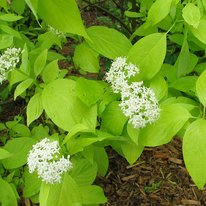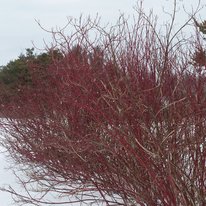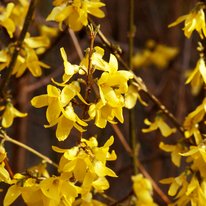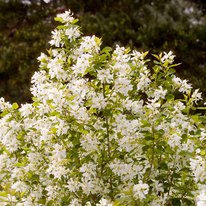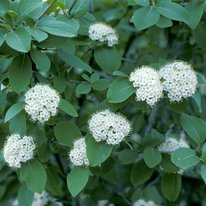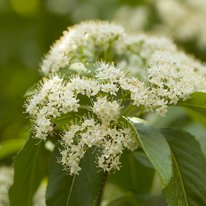No garden is complete without shrubs—to provide privacy when planted as a hedge, give wildlife food and shelter, create a beautiful backdrop for smaller plants, and offer flowers, fragrance, and shade. The University of Minnesota woody landscape breeding program has developed several hardy shrubs that thrive in Minnesota's climate.
Dogwood (Cornus)
The underlying rosy hue of dogwood branches provides bright landscape color through even the most severe Minnesota winter. The extensive root system tolerates poorly drained soil, and can be useful for erosion control. Small white flowers appear in June, followed by white berries that many birds and other wildlife find appealing.
University of Minnesota Dogwood (Cornus) Varieties
Cardinal
- White flowers that bloom from May to June
- Youth twig growth is bright red for winter
- Grows well in full sun or partial shade
- 8-10' plant size
- Released in 1986
Garden Glow™
- Small white flowers in late spring, white berries mid-summer
- Brilliant yellow-green foliage and red stems in winter
- Thrives in shade
- 6' plant size
- Released in 2001
Isanti
- Small white flowers in spring
- Mound shape plant with fine twigs covered in red bark
- Slower-growing than other native dogwood varieties
- 4-5' plant size
- Released in 1971
Forsythia
The bright yellow flowers of forsythia appear before the leaves, signaling the arrival of spring. A forsythia's vigorous growth makes it suitable for screens and bank plantings. 'Northern Sun' was bred to flower in early spring despite cold temperatures.
University of Minnesota Forsythia Variety
Northern Sun
- Bright yellow blooms
- Hardy to -30°F
- Fast growing and thrives in sun
- Tolerates a wide range of soils
- 10' plant size
- Released in 1982
Ninebark
Common ninebark is a versatile deciduous flowering shrub widely used in landscaping. It gets its name from its bark, which can be peeled off in several thin layers. Native to Missouri, it prefers full to partial sun in cooler climates. University of Minnesota ninebark varieties have excellent cold hardiness. Late spring to early summer blooms are white or pink and foliage is typically gold, red or purple. They are typically widely adaptable to various soil types and are easy to grow in the home garden.
University of Minnesota Ninebark Varieties
Center Glow
- Pinkish-white flowers bloom late spring
- New leaves have an attractive glowing center of golden yellow, before the leaf turns entirely red
- In fall the seed pods turn bright red, lasting into the winter months
- 6-8' plant size
- Released in 2012
Fireside™
- Pinkish-white flowers bloom in the spring
- Reddish new growth matures to deep red-purple foliage that holds its color reliably all summer then turns deep purple in fall
- Habit is tidier than other Physocarpus with a rounded, upright shape
- 5-6' plant size
- Released in 2018
Pearlbush
'Northern Pearls' is the only selection of pearlbush hardy for Minnesota. Its name comes from its flower buds, arrayed like pearls along a stem. In early May, each bud opens into a showy white flower, two inches across. It can be pruned to a single trunk for a small tree, or grown as a five- to eight-foot shrub.
University of Minnesota Pearlbush Variety
Northern Pearls
- Pearly white, attractive flowers
- Showy exfoliating bark
- 5-8' plant size
- Released in 1995
Viburnum
The University's two hardy viburnum varieties have great potential as buckthorn replacements in Midwestern landscapes. Commonly known as nannyberry, the bushes feature dark green, glossy foliage and creamy white flowers in late spring. The compact shrub grows 6 to 10 feet wide and high with dense foliage, making it an ideal choice for screen hedges.
University of Minnesota Viburnum Varieties
Emerald Triumph
- White, showy and nearly flat flower clusters in mid-May
- Hardy to -30°F
- Best in full sun to part shade and in well-drained soil
- 6-10' plant size
- Released in 1994
HomeFree™️
- White, flat clusters of flowers that bloom mid-May
- Especially resistant to powdery mildew
- Hardy to -30°F
- Best in full sun to part shade and in well-drained soil
- 6-10' plant size
- Released in 2018
Golden Glow™, Fireside™ and Homefree™ are trademarks of the University of Minnesota.


